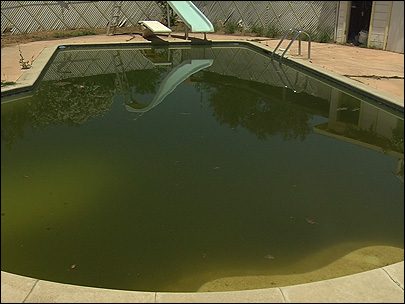


How to Clean a Pool After Heavy Rain to Avoid Algae Growth
When a heavy downpour hits, your pool often bears the brunt of it — cloudy water, floating debris, and fluctuating chemical levels. What was once a sparkling oasis can quickly turn into a breeding ground for algae. While rainwater itself may seem harmless, it can drastically alter your pool’s chemical balance and introduce contaminants that promote algae growth.
If you live in suburbs prone to unpredictable showers, knowing how to clean your pool effectively after heavy rain is key to maintaining clear, healthy water. This detailed guide will help you restore balance, prevent algae formation, and get your pool swim-ready again.
The first step after a rainstorm is to clear out all visible debris. Use a pool skimmer or leaf net to remove leaves, twigs, flowers, and insects that might have been blown in by the wind. Rain often brings organic materials into your pool that can decompose quickly, releasing phosphates that feed algae.
It’s equally important to inspect the water level. Heavy rain can cause your pool to overflow or rise above the skimmer line, preventing the filtration system from working effectively. If the level is too high, drain the excess water using your backwash setting or a submersible pump until it’s halfway up the skimmer opening.
Prompt debris removal and proper water levels will make the following steps more effective, setting the foundation for balanced, algae-free water.
Rainwater can dramatically affect your pool’s chemistry. Because it’s slightly acidic, it tends to lower the pH and alkalinity, while diluting chlorine and other sanitizers. This creates ideal conditions for algae to bloom.
After a storm, use a reliable testing kit or digital tester to check:
pH Level: Ideally between 7.2 and 7.6
Alkalinity: Between 80 and 120 ppm
Chlorine Level: Between 1 and 3 ppm
Calcium Hardness: Between 200 and 400 ppm
If your readings fall outside these ranges, add the appropriate chemicals to restore balance. A pH that’s too low can corrode equipment and irritate skin, while a lack of chlorine allows bacteria and algae to thrive.
For homeowners who want expert help after a storm, Pool Cleaning Toorak professionals can restore your pool’s balance quickly and ensure long-term water stability without guesswork.
Once your water chemistry is balanced, it’s time to circulate and filter the water thoroughly. After heavy rainfall, your pool is full of tiny particles — dirt, pollen, and organic matter — that can make the water cloudy or promote algae growth. Running your pump and filtration system for 24 to 48 hours helps remove these contaminants and evenly distribute sanitizing chemicals.
If your filter hasn’t been cleaned in a while, backwash or rinse it before running continuously. This step ensures optimal water flow and efficiency. A clean filter not only removes impurities faster but also prevents cloudy water from lingering.
If you live in a lush suburb with lots of trees, like Toorak, regular filtration maintenance is even more critical, as fine organic debris and dust often enter the pool after storms.
Even if your chlorine levels seem fine, it’s smart to shock your pool after heavy rainfall. Shocking introduces a large dose of chlorine (or a non-chlorine oxidizer) to destroy bacteria, organic matter, and algae spores that may have entered during the storm.
Follow the manufacturer’s instructions carefully and add the shock treatment in the evening to avoid sunlight degradation. Let your pump run overnight to circulate the shock evenly. By morning, your pool should look noticeably clearer, with improved water quality and sanitation.
In rainy areas like Toorak, it’s wise to shock your pool after every major storm, especially during warmer months when algae thrive.
Rain doesn’t just affect the water — it also impacts your pool surfaces. Dust and debris that settle during rainfall can form a thin layer on the walls and floor, encouraging algae to take hold. Use a pool brush to scrub all surfaces, focusing on corners, steps, and tile lines where algae typically begin to grow.
After brushing, vacuum the pool manually or use an automatic pool cleaner to remove loosened particles. Vacuuming after rainfall ensures that contaminants and sediment don’t linger at the bottom, keeping your water clear and balanced.
Brushing and vacuuming also enhance the efficiency of your shock treatment and filtration, giving your pool a fresh, polished look.
Sometimes, even after proper cleaning and filtration, your pool water may look cloudy. This is usually due to fine particles that are too small for your filter to catch. A pool clarifier binds these particles together so the filter can trap them effectively.
Add the clarifier as per the product’s instructions, allow your system to run for several hours, and watch your pool regain its crystal-clear appearance.
Regular use of clarifiers after rainfall can prevent recurring cloudiness — a common issue for suburban pools surrounded by gardens and trees.
Cleaning your pool after every rainfall is essential, but prevention is even better. Here’s how to stay ahead of algae:
Use a quality pool cover during forecasted rain.
Maintain proper sanitizer levels weekly.
Brush and skim your pool regularly.
Trim surrounding trees to reduce leaf litter.
Clean your filter at least once a month.
In areas like Toorak, where sudden showers can strike without warning, keeping your pool chemistry balanced and your filtration system in good condition will dramatically reduce post-rain problems.
Heavy rain can throw your pool’s ecosystem off balance, but quick and proper care can prevent long-term damage and algae blooms. By removing debris, rebalancing chemicals, running your filtration system, and shocking the water, you can restore clarity and hygiene in no time.
For pool owners in suburbs such as Toorak, where lush greenery and sudden storms often collide, staying proactive with your maintenance routine is the best defense. A little attention after each rainfall ensures that your pool remains an inviting, algae-free retreat — no matter what the weather brings.
